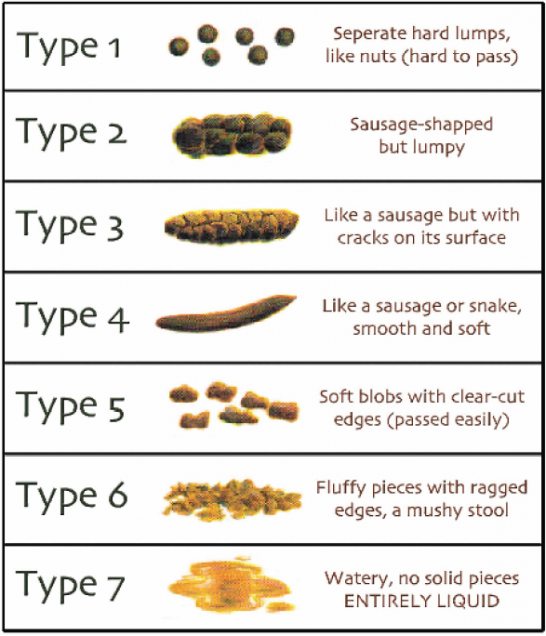Poop Talk

Pay close attention to your bowel movements (or lack of). It can provide important information about your health.
Type 1: Separate hard lumps, like nuts, are hard to pass. Experts say this could be an indicator of constipation.
Type 2: Sausage-shaped but lumpy. This is also an indicator of constipation and, possibly, dehydration.
Type 3: Sausage-shaped, but with cracks on its surface. It does not take longer than a minute on the toilet to push out. This is a healthy stool.
Type 4: Sausage – or Snake-like and smooth and soft. This is the kind of poop you want to have. This is considered a healthy stool.
Type 5: Soft blobs with clear-cut edges; easy to pass. You may have a sense of urgency about getting to the bathroom which is a sign of mild diarrhea. You may need more fiber in your diet.
Type 6: Fluffy pieces with ragged edges and mushy. If you have more than three of these a day, you have diarrhea. You are losing minerals that the body should be absorbing. This category on the Bristol Stool Chart could indicate inflammation of the bowel.
Type 7: Water, no solid pieces and entirely liquid. They type of stool moves through your bowel very quickly. This is a sign a person is unwell, which could be caused by a virus, bacteria or a parasite.
Stool Color Color is not included in the Bristol chart but can also be helpful when looking at your health. The color of your stool depends on diet and how much bile is in it. Bile is a yellow-green fluid dedicated to helping digest fats. A healthy stool reflects a mixture of all the colors of the food you have eaten and bile.
Brown: Almost any shade of brown, or even green, is normal.
Green: If you eat a lot of vegetables (which is good), or too much green food coloring (not good) your stool may be green. However, if you are seeing this with Types 5, 6, or 7, it may mean that food is moving through your body too quickly. The bile does not have time to break down and you are getting rid of it before absorption occurs.
Red: This may be from eating too much red food coloring (not good). It can also be due to red-colored medication. If this is the case, it should resolve itself within a couple of days. However, a bright red stool could be blood from large intestine or rectum. It may also be from a scratch or hemorrhoid. Please check with your doctor if you keep passing red stools.
Black: This can be caused from synthetic iron supplements, over the counter medications taken stomach-aches or food that is colored black. Pay attention to black stools that appear dark maroon, smells bad or looks tarry. It may be a sign of bleeding in the digestive track. You should contact your doctor.
Light Colors: Yellow is expected with infants who are breast fed and is healthy. However, if not, it could be a sign of too much fat in your diet. It may also mean you are having a hard time absorbing nutrients. Chalky white may be a side effect of medication or something else so let your doctor know if it continues.